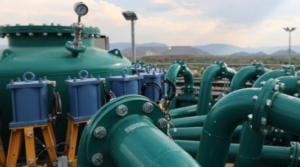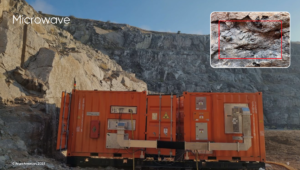At the recent Bank of America 2023 Smart Mine 4.0 conference, Donovan Waller, Anglo American Group Head of Technology Development gave an in-depth review of ongoing projects under its FutureSmart Mining™ banner, which broadly refers to its innovation-led approach to sustainable mining.
He covered mainly six interesting areas – its African renewable energy ecosystem; the nuGen™ Zero Emission Haulage Solution being led by engineering partner First Mode; Coarse Particle Recovery (CPR); Hydraulic Dewatered Stacking; copper leaching; and microwave based preconditioning.
Then he closed with two tantalising glimpses into earlier stage projects – namely “Haulage re-defined” where he shared an image showing what appeared to be a machine along the lines of an MMD Fully Mobile Surge Loader, working with smaller class, cabless, autonomous and likely battery electric trucks. He also shared some images of possible intelligent logistics concepts of the future.
On energy, in South Africa last year Anglo American entered into partnership with EDF Renewables – creating Envusa Energy, and announced the first 600 MW of wind and solar projects, intended to form the development of a broader regional renewable energy ecosystem (RREE) expected to generate 3-5 GW over the next decade. It has agreed commercial terms for two wind sites of 140 MW each and one solar site of 200 MW in the Eastern Cape. It is aiming for financial close in Q3 for these sites to commence construction immediately. Anglo is also developing 2 large solar sites in our mines at Sishen and Mogalakwena.
IM has published much already on the next topic of the nuGen™ Zero Emission Haulage Solution – the prototype of which, truck DT74 achieved a year of successful operation at Mogalakwena, during which time it was introduced into a mixed commercial fleet, including ore and waste haulage activities, alongside diesel vehicles, with over 1,200 hours of operation.
Then on the four more downstream areas – on CPR, following its construction in 2021, the Coarse Particle Recovery unit at El Soldado copper mine in Chile was successfully handed over to operations, having exceeded targets in energy unit consumption and enabling a 16% increase in copper production without the need for additional energy. Waller: “It beat every single metric we had set for it before we started the project.”
The innovative flotation process, which permits material to be ground to a larger particle size, allowing the early rejection of coarse waste and greater water recovery, has already begun producing the coarse waste which is used in the nearby Hydraulic Dewatered Stacking (HDS) pilot.
Full-scale CPR plant has been constructed at the Mogalakwena North concentrator

A full-scale CPR plant has been constructed at the Mogalakwena North platinum concentrator, with start-up anticipated in late 2023. Construction of a full-scale CPR plant at Quellaveco in Peru to treat flotation tailings began in July 2022, with commissioning planned for late 2023. Future plans for CPR include Los Bronces, Minas-Rio and Collahuasi. “CPR has not only demonstrated value, but, like many of our other technologies, provides a strong platform to build on going forward.”
There was a lot of HDS progress which Waller said has successfully been demonstrated at El Soldado mine. “HDS was developed after the Brumadinho disaster as our engineers hypothesised that the fines free sand available from CPR (and readily available from many tailings) could be used to build a three dimensional drainage system to rapidly desaturated hydraulically placed tailings.” The idea has been iterated, developed and progressed to a stable tailings stack that can dewater (and desaturate) in days and weeks rather than years and decades.
The 150,000 m3 capacity full-scale demonstration facility in El Soldado utilises fines-free sand from the CPR plant at El Soldado, the largest such plant currently in operation at a base metals mine. Waller: “Initial results demonstrate over 80% water recovery but more importantly, a final stack with lowered saturation levels, greatly reducing both the likelihood and consequence of liquefaction.”
During June 2023, Anglo American initiated a second trial at Mogalakwena platinum mine in South Africa, targeting the application of HDS into an existing facility. “This is significant in that existing facilities can, in some instances, be reconfigured mid-life to take advantage of HDS. We are currently assessing the possibility of this at Los Bronces.” He added that the commercialisation of and acceleration of the development of the technology has started and agreements with geotechnical designers are expected to be signed in the next couple of months.
Waller continued: “Discussions with mining companies are progressing and we are targeting at least two joint development trials to begin in 2024. We are proposing a collaborative approach under license that accelerates the learning further and ensures that each application improves and hence we are able to quickly implement this technology, where applicable, to demonstrably reduce the risks of tailings management – changing the conversation from one of risk mitigation to one of opportunity; where the land used for tailings storage can quickly and efficiently put to re-use and be of benefit to all stakeholders.”
Then it was onto leaching, where Waller said it had had developments in the works over the last few years “which show significant benefits over what we have seen from others to date.” Anglo’s SandLix™ it says unlike others, considers three elements: particle size, temperature and chemistry. The method unlocks metal recovery from low-grade, refractory sulphide ore at low intensity.
“Results on primary copper ores show recoveries of over 70% in half the time of traditional leaching methods. We ultimately see this technology replacing conventional concentrator circuits and delivering metal more responsibly – and, at roughly half the embodied water and energy intensity. We have demonstrated excellent results in column tests of up to 18 metres and our team are currently progressing parallel work programs to scale the technology up. We are actively accelerating this work and are currently negotiating agreements with partners to explore outcomes commercially.”
Testing of microwave rock pre-conditioning in a surface quarry

Moving onto newer concepts – he also talked through its work on preconditioning ores with microwaves to weaken them for both rock cutting and downstream comminution processes. Waller: “Specifically, directed and controlled microwave energy can induce thermal stress which fractures the rock mass and reduces its inherent strength. The implication is the possibility of accelerated mining & development rates, hopefully allowing for access to ore bodies quicker and to mine them faster.”
He said that over the past few years it has tested application methods and the effect on in-situ ores in both underground and surface mines. “We are currently testing a production cutter in a quarry and if successful we will install a first-generation microwave preconditioning system in a production environment at an Anglo American site in 2024.”
A tantalising glimpse of the kind of future haulage concepts Anglo is looking at was also given. Waller said mining has used trucks & shovels for the past one hundred years – probably the most successful combination of mining technology ever. “I attribute their success predominantly down to flexibility, reliability & scalability. We stepped into this hallowed ground and allowed ourselves a blank sheet exercise to address the shortcoming of mining trucks, namely: cost, speed & energy consumption.”
By adjusting the base operational assumptions of loading, and working with vehicle designers and tyre producers Anglo says it has re-imagined weight distribution, symmetry, modularity and designing using only off the shelf components. “We surprised ourselves and have created a unique alternative value proposition, using the vehicle as a sensor, almost halving the energy used, increasing speed & effectiveness, all at a reduced cost. Whilst still early days – we have the makings of a future mining system focused on precision.”
Finally and in parallel to this – work on intelligent logistics seeks to redefine materials movement, efficiency and scalability. “Using linear motor technology coupled with new powerful and cost-effective distributed computing technology we have developed the individual elements of a scalable, self-configuring, mine logistics system that is capable of handling typical material movement out of and logistics requirements into a mine.”
This novel system provides high capacity (~40 Mt/y) with a very small footprint; energy per ton kilometre material moved is an order of magnitude lower than conveyor systems; it is modular, flexible, easy to install within changing mine requirements; it allows high precision control of small strategic mining units to and from multiple destinations; and it has the ability to travel both horizontal and vertically.
He added: The result drives new thinking for both underground and surface mine designs. With both this and the previous technology shown, we are looking to partners to progress the development and building of the first pilot systems to validate mine-ready systems.”











